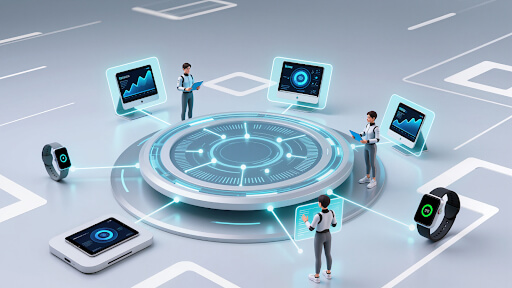 1-800-805-5783
1-800-805-5783 
The era of treating Generative AI (GenAI) as a simple “chatbot” is over. As we near the end of 2025, successful enterprises are no longer just talking to AI; they are building complex Generative AI workflows that act, reason, and execute business processes autonomously.
According to Gartner, worldwide spending on GenAI is projected to reach $644 billion in 2025, yet nearly 30% of GenAI projects are expected to be abandoned after the Proof of Concept (PoC) phase. The difference between the winners and the failures often lies in one specific area: the architecture of their workflows.
This guide provides an in-depth look at understanding, designing, and optimizing Generative AI workflows for business automation, moving beyond simple prompts to robust, scalable agentic systems.
In 2023 and 2024, the focus was on “Prompt Engineering”—crafting the perfect text to get an answer. In 2025, the paradigm has shifted to Agentic AI.
A Generative AI workflow is not a single interaction. It is a chain of automated steps where an AI model (or a team of “agents”) perceives a trigger, retrieves necessary context, reasons through a problem, and executes a business action.
McKinsey’s State of AI 2025 report highlights that high-performing organizations are now using “agents”—systems capable of planning and executing multiple steps to achieve a goal—rather than just passive text generators.
To build a workflow that drives business automation, you need to understand its five core components. Think of this as the “digital assembly line” for your data.
Every workflow needs a distinct starting point. In business automation, these are typically:
A generic model (like GPT-4 or Claude) doesn’t know your business. To fix this, effective workflows use Retrieval-Augmented Generation (RAG).
This is the most critical layer in 2025. Orchestration frameworks (such as LangChain or LangGraph) manage the logic. They determine:
This is where the “Generative” part meets “Automation.” The AI is given access to APIs—essentially “hands” to perform tasks.
For high-stakes business automation, the “Human-in-the-Loop” is a feature, not a bug. It acts as a safety valve.
Also read: The Complete Guide on How to Build Agentic AI in 2025

Let’s visualize this with a concrete, high-value example: Automated Invoice Reconciliation.
While the potential is immense, the risks are maturing alongside the technology.
Shadow AI refers to employees connecting unsanctioned AI tools to enterprise data. In 2025, this has evolved to “Shadow Agents”—employees creating autonomous workflows that might inadvertently leak sensitive PII (Personally Identifiable Information) or hallucinate financial promises to customers.
An autonomous agent designed to “optimize cloud spend” might inadvertently shut down critical servers if its parameters aren’t strictly “scoped.”
As the EU AI Act and other global regulations come into full force, businesses must ensure their workflows are explainable. If a loan is denied by an AI workflow, you must be able to trace exactly why that decision was made. “Black box” automation is a liability.
To ensure your Generative AI workflows deliver ROI and don’t end up in the “failed PoC” graveyard:

A Generative AI workflow is a structured sequence where AI models retrieve context, reason through tasks, interact with tools, and execute actions. It sits at the core of modern Generative AI tools, enabling them to participate in complex, multi-step automation rather than single-response interactions.
A chatbot gives you answers. A Generative AI workflow completes work. It can update systems, generate reports, trigger alerts, reconcile invoices, and ask for human approval when needed. These are real Generative AI workflow examples that show how companies are using automation to replace manual processes and reduce turnaround times.
Start with repetitive, rules-heavy tasks that drain time but don’t require deep judgment. IT ticket triage, contract summarization, finance validations, and compliance checks are strong candidates for early Generative AI workflow adoption.
Yes—especially in finance, legal, healthcare, HR, and other sensitive areas. Human-in-the-loop checkpoints keep the workflow accurate, safe, and compliant. Oversight doesn’t slow you down; it prevents expensive errors.
Most teams use a mix of RAG pipelines, vector databases, orchestration frameworks (like LangGraph), evaluation suites, and API integrations. Together, they create the structure that lets a Generative AI workflow operate consistently and autonomously.
Understanding a Generative AI workflow for business automation is about moving from novelty to utility. When companies treat AI as a system of agents, triggers, context pipelines, and controlled execution layers, they create a Generative AI workflow that actually performs work—not just produces text. This approach also sets the foundation for Generative AI workflow automation, where end-to-end processes run reliably without human micromanagement.
As more enterprises adopt automated processes, the ability to architect a reliable Generative AI workflow becomes a competitive advantage. It turns scattered experiments into a scalable operating model. A well-designed workflow also becomes the backbone of Generative AI workflow optimization, helping teams track performance, tighten reasoning steps, and reduce operational friction.
The winners of 2025 will be those who stop asking what they can ask the AI and start building Generative AI workflows that let AI take on measurable, auditable business actions. When your business can delegate full processes instead of isolated tasks, you unlock productivity gains that compound over time through automation using Generative AI.
At [x]cube LABS, we craft intelligent AI agents that seamlessly integrate with your systems, enhancing efficiency and innovation:
Integrate our Agentic AI solutions to automate tasks, derive actionable insights, and deliver superior customer experiences effortlessly within your existing workflows.
For more information and to schedule a FREE demo, check out all our ready-to-deploy agents here.